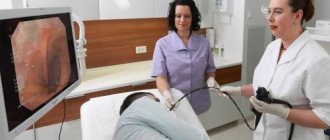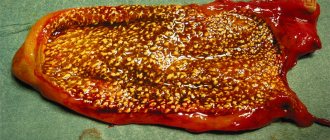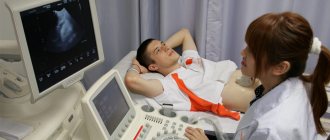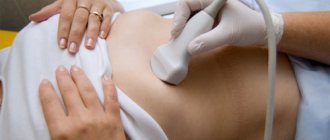Anomalies in the shape of the gallbladder are the most common type of abnormality. Among them:
- S-shape;
- spherical;
- resembling a boomerang;
- kinks;
- constrictions;
- protrusion (gallbladder diverticulum).
Not all of them are congenital anomalies: kinks and constrictions often cause bladder mobility. Sometimes developmental defects associated with the form correct themselves, but sometimes they are dangerous and require special treatment or surgery. The most common and dangerous deviations are kinks, constrictions and diverticulum. They have their own characteristics:
Deviation type
Description
This deviation causes the gallbladder to curl up like a snail shell and attach tightly to the duodenum. Sometimes it attaches to the colon. Depending on whether it is possible to eliminate the problem on your own over time or whether the help of a specialist is needed, kinks are divided into functional and true.
This deviation can occur either as a result of a congenital defect or due to mobility of the gallbladder, as well as several other, more rare, reasons. Causes a narrowing of the entire organ or any part of it, which interferes with normal functioning and causes problems with the passage of bile. Subsequently, it can provoke depletion of the walls of the bladder and the ability to contract.
Independent elimination of the problem is possible if it was initially caused by inflammatory processes in the serous membrane.
Occurs when the gallbladder does not have an elastic frame. In this case, one of the walls protrudes and takes on a bag-like shape. This condition provokes disruption of the functioning of the gallbladder, inflammation, stagnation of bile, and stone formation. Often accompanied by severe pain.
Along with their prevalence, these deviations are also the most dangerous. Sometimes they can lead to death.
Size anomalies
Anomaly of the gallbladder relative to normal size is divided into 2 main types:
Type of anomaly
Description
It is characterized by a uniform increase in all parts of the gallbladder with the exception of the ducts. Maintains the homogeneity of the internal fluid and does not require additional thickening of the walls.
There is a uniform decrease in the size of the gallbladder while maintaining its normality and adequate functioning.
Gallbladder hypoplasia
The bubble is either very small or completely underdeveloped. This deviation can affect the entire bubble or any part of it.
With the exception of hypoplasia, which often provokes inflammation, anomalies of this type in most cases do not require surgical intervention.
Associated anomalies
Among the accompanying anomalies, for the most part, disorders of the bile duct:
- Atresia of the gallbladder (also known as underdevelopment of the bile ducts).
- Stenosis (narrowing of the duct).
- The appearance of accessory ducts.
- The occurrence of a common bile duct cyst.
- Formation of biliary sludge.
Many of them are a direct consequence of abnormalities in the gallbladder itself. They have the following features:
Deviation type
Description
A congenital malformation in which there are no bile ducts, or they are underdeveloped and unsuitable for performing their functions. Requires surgery.
Narrowing of the bile ducts can be caused either by their underdevelopment or pathologies of the bladder, or develop as a result of thickening of the walls of blood vessels and their replacement with fibrous tissue. Usually solved by shunting, an artificial dilation of the duct.
They are additional “branches” connecting the gallbladder to the body. As a rule, their number does not exceed 2–3. Usually asymptomatic and do not affect the functioning of the body. Sometimes ducts of a false type appear, unable to conduct bile flow.
Dilation of the duct, which has a saccular shape. Often it does not appear at all.
It is not one of the pathologies affecting the bile ducts. It is characterized by the appearance of a bile suspension at the bottom of the bladder. Typically occurs as a result of diverticulum or constriction. Causes inflammation, stone formation and depletion of organ walls.
These anomalies must be monitored and kept in mind both in adult patients and in children: during surgery they can cause complications or provoke the development of a new pathology.
Symptoms
The changes are usually congenital or acquired.
In the first case, a person may not even know about the presence of defects if they are mild and the overall functioning of the digestive system is not impaired. He has no signs of illness. The deficiency can only be identified by undergoing an ultrasound examination in cases of disease of other internal organs or forced surgery.
With congenital deformation, the following symptoms are observed:
- The skin takes on a yellowish tint.
- A specific coating appears on the tongue and a bitter taste in the mouth.
- Sometimes it can make you feel nauseous.
- There is slight pain in the liver area.
- Lack of healthy appetite.
- The temperature rises above normal.
- When palpating the abdomen, pain and discomfort occur.
The defect can also be acquired. In this case, all its signs will depend entirely on how the pathology formed and its degree.
With constant exacerbations and improper flow of bile, a person experiences symptoms such as:
- feces are light in color, and urine, on the contrary, darkens;
- weight loss;
- frequent vomiting;
- poor appetite;
- bitterness in the mouth;
- constant feeling of heaviness and bloating in the stomach;
- pain syndromes;
- diarrhea;
- constipation;
- general weakness and malaise.
All these signs tell a person that there is a disturbance in the functioning of the digestive system. If the failure is not responded to in any way, it will provoke the development of complications.
One of the most terrible and dangerous situations is the development of necrosis. It starts from the bladder neck area. If nothing is done, the dead tissue will disintegrate, allowing bile to freely penetrate into the abdominal area.
The person is experiencing severe pain at this moment. If medical care is not provided, death will occur within 12 hours after the onset of the internal inflammatory process.
Who said that it is impossible to cure severe gallbladder diseases?
- Many methods have been tried, but nothing helps.
- And now you are ready to take advantage of any opportunity that will give you the long-awaited well-being!
An effective treatment for the gallbladder exists. Follow the link and find out what doctors recommend!
Version: MedElement Disease Directory
October 24-25, Kazakhstan, Nur-Sultan
New venue! Astana-EXPO territory, pavilion C3.5
Get a free ticket
International Healthcare Exhibition
October 24-25, Kazakhstan, Nur-Sultan
New venue! Astana-EXPO territory, pavilion C3.5
Get a free ticket
general information
Short description
Gallbladder agenesis is a rare congenital anomaly that results in the absence of a gallbladder. In this case, the cystic duct is usually absent and dilatation of the common bile duct may be noted.
Agenesis of the gallbladder with a normal bile duct is extremely rare. According to some reports, in this case, only fatty tissue and gallbladder arteries are found in place of the gallbladder.
Aplasia and hypoplasia of the gallbladder are underdevelopment of the gallbladder in its correct position.
October 17-19, Almaty, Atakent
200 participating companies, seminars and master classes, discounts, prize draws
Get an invitation card
October 17-19, Almaty, Atakent
200 participating companies, seminars and master classes, discounts, prize draws
Get an invitation card
Differential diagnosis
Differential diagnosis, if necessary, is usually carried out with the following conditions: – cholecystitis; – diseases accompanied by impaired bile passage; – volumetric processes that can cause displacement of the gallbladder and ducts; –
gallbladder agenesis
; – anomalies in the development of ducts; – local accumulation of fluid in the abdominal cavity; – cysts of the porta hepatis and head of the pancreas; – biliary
hypertension
– in case of gallbladder interposition.
Risk factors and groups
Main risk factors:
1. Hereditary connective tissue disorders - undifferentiated connective tissue dysplasia.
2. Duplication syndrome of chromosome 1q (trisomy 1q) - agenesis and aplasia occur in combination with other anomalies.
3. Warkany syndrome (Warkany, Josef -American human geneticist, 1902-1992) is a syndrome of multiple developmental defects associated with complete or partial trisomy of chromosome 8q (the presence of an additional chromosome 8 or part of its short arm). There are reports of about 100 cases of observation of agenesis of the gallbladder in this syndrome, i.e. it occurs inconsistently, being combined with other anomalies of 8q syndrome.
4. Trisomy 11 chromosome (doubling 11q) in combination with other manifestations.
5. The presence of other malformations of the digestive tract.
Types of pathology in children and the reasons for their development
The anomaly can be either congenital or acquired. Congenital is formed during the first months of pregnancy and manifests itself in the baby at the age of two to three years when transferred to a normal diet.
Causes of congenital pathology:
- bad habits of the mother (drinking alcohol, passive or active smoking);
- infections during pregnancy;
- the effect of medications during pregnancy;
- chronic maternal illnesses.
Causes of acquired pathology:
- inflammatory processes of the gastrointestinal tract;
- excessive physical activity, heavy lifting;
- nervous and emotional overload;
- the predominance of junk food.
The type of bends is determined by the location of the constrictions. More common are kinks between the bottom and body of the gallbladder. Less common are the most dangerous deformations in the area of the body or bottom of the organ: such changes cause an accumulation of bile and put excessive pressure on the ducts, which can cause perforation of the organ. Less common are congenital hook-shaped and s-shaped forms. They are formed by two bends. Spiral bends in the organ are characterized by its triple twisting.
Diagnostics
Diagnosis of hypoplasia
Cholecysto- and cholegraphy show that the shadow of the gallbladder is absent or sharply reduced while the function of the gallbladder is preserved. Ultrasound and radiocholecystography with dynamic scintigraphy can detect a decrease in the cavity of the gallbladder, and sometimes its absence.
Detection of agenesis or aplasia of the gallbladder in most cases occurred accidentally during laparoscopic interventions, before which only ultrasound was performed. Practice shows that if the gallbladder is not clearly visualized on ultrasound, patients should undergo CT and MRI.
Treatment methods for cholelithiasis
Diagnostics
To determine for sure whether stones are present in the patient’s gall bladder, an ultrasound examination of the abdominal organs is sufficient. Today, when confirming the diagnosis, doctors most often decide on cholecystectomy.
However, the specialist may not incline the patient to radical surgical treatment if the formations cause virtually no discomfort. In this case, experts recommend undergoing a course of treatment aimed directly at the biliary tract. Symptoms of the disease that do not manifest themselves in any way allow the use of the method of influencing the ducts with ursodeoxycholic and chenodeoxycholic acids.
Its advantage is the ability to get rid of stones in a non-surgical way. Disadvantages include a high probability of relapse. A therapeutic course lasting about a year in most cases gives an imaginary, short-term result, since patients often experience re-inflammation just a few years after long-term treatment. It is also worth noting that this treatment option is only available in the presence of cholesterol stones not exceeding 2 cm diameter.
No conservative method of therapy can eliminate a violation of the shape of the gallbladder, regardless of whether it is congenital or acquired. All non-surgical techniques are aimed at relieving symptoms.
For this purpose, use:
- Following a diet with limited consumption of fatty, fried and spicy foods, and alcoholic beverages.
- Choleretic drugs (Alohol, Holiver, Hofitol).
- Antispasmodics (No-shpa, Baralgin).
- With the development of acute cholecystitis - antibacterial agents.
People with gallbladder pathology benefit greatly from normalizing and maintaining a healthy weight through proper nutrition and moderate exercise.
Folk choleretic herbal remedies:
- corn silk;
- rose hip;
- immortelle;
- coltsfoot;
- St. John's wort;
- tansy;
- calendula.
Choleretic infusions are often made from these plants.
If traditional methods of treatment and conservative therapy are ineffective, or complications develop, a cholecystectomy operation is performed - removal of the gallbladder. As a rule, it is done using laparoscopic methods - through several small incisions in the abdomen using a video camera and special instruments.
The gallbladder in most people is pear-shaped. Some patients may have abnormalities in the shape, position, number, and size of this organ. Typically, these abnormalities are congenital and do not cause any symptoms.
Hypoplasia of the gallbladder in adults, what does it mean?
Anomalies of the biliary tract are congenital defects and malformations, accompanied by a violation of the drainage function of the biliary system, the development of pathological processes and, as the latter progress, manifesting certain symptoms (Fig. 1). Until now, there is no generally accepted classification and nomenclature of variants and anomalies in the development of the organs of the biliary system. Thus, some authors believe that all changes in the biliary system (from minor deviations to deformities incompatible with life) are anomalies. According to others, only defects and malformations that are accompanied by a violation of the drainage function of the biliary system should be classified as anomalies. It is noted that the biliary system has wide limits of individual variability. There are different points of view on the issue of inheritance of gallbladder anomalies. These deviations can be inherited either dominantly or recessively. One of the factors in the development of tissue dysplasia (in particular cysts) is chlamydial infection. However, it should be noted that anomalies and malformations of the biliary tract in most cases are accompanied by impaired motility of the gallbladder. In this regard, anomalies can be considered a risk factor for the development of functional and organic pathology.
Signs
The symptoms of the anomaly depend on the speed of spread of the pathological process. Since bile is responsible for the process of breaking down food, the first signs of the disease are heaviness in the abdomen, a feeling of bitterness in the mouth, pain in the right hypochondrium, and heartburn. The patient's internal anxiety grows spontaneously.
- nausea, vomiting;
- systematic bloating after a meal;
- belching;
- severe signs of dyspepsia, indigestion;
- acute pain in the right hypochondrium, which radiates to the scapula, collarbone, and spinal column.
The task of doctors is to correctly differentiate the disease. This is explained by the fact that the patient may have echo signs of diseases such as:
- cholelithiasis;
- inflammatory processes;
- complications of hepatitis;
- tumors of various origins;
- diseases of the digestive system.
As a rule, exacerbation of cholecystitis, as well as other diseases affecting the biliary tract, occurs after the patient relaxes the strict dietary regimen. Having allowed himself even the smallest amount of something harmful, he will soon regret it. Painful symptoms of cholecystitis under the right rib, radiating to the subscapular region and supraclavicular area, do not allow you to forget about the disease, even for a short time.
Elderly people who have had a myocardial infarction may experience pain in the chest space due to cholecystitis. Reflex type angina is further accompanied by nausea and vomiting. Vomit initially represents the contents of the stomach, i.e., what the patient ate the day before; then only bile can be released.
An increase in body temperature cannot be considered a mandatory symptom of cholecystitis. The absence of fever does not at all indicate the absence of inflammation. Palpating the abdomen, the doctor in most cases notes tension in the abdominal muscles, soreness of the gallbladder, which becomes more and more like a small ball in the right hypochondrium.










